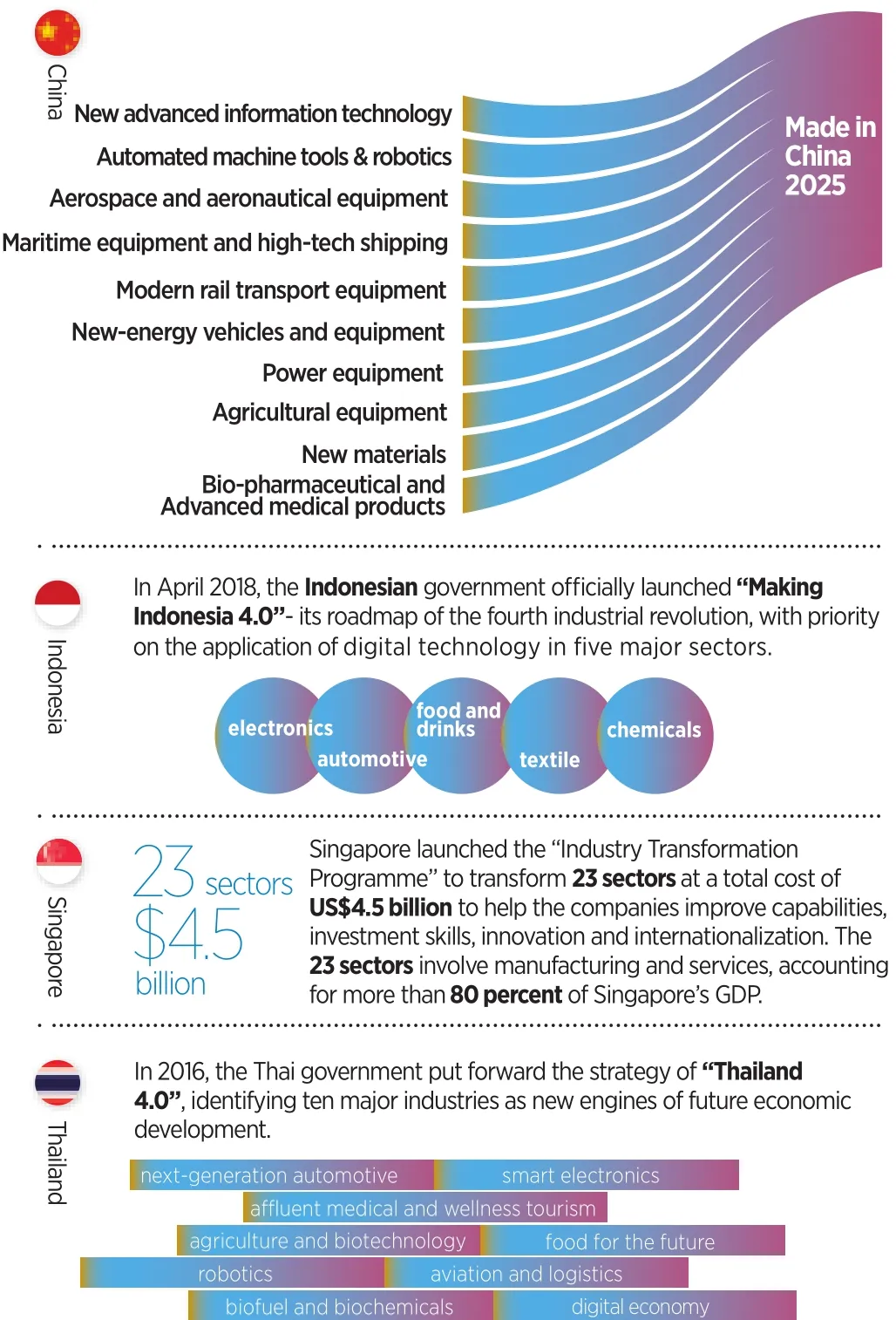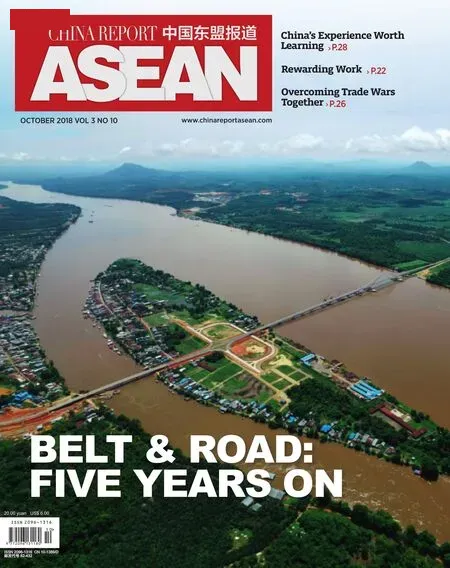INDUSTRY 4.O & REGIONAL PRODUCTION CAPACITY COOPERATION
By Wang Qin
In recent years, China and ASEAN member states have successively introduced the strategy of “Industry 4.0” to cope with the opportunities and challenges brought about by the fourth industrial revolution with the adjustment and upgrading of industrial structure. Within the strategic framework of “Industry 4.0”, China and ASEAN countries have a broad space for cooperation in the transformation of traditional industries and the development of emerging industries.
Strategy of ‘Industry 4.0’
In May 2015, the Chinese government launched“Made in China 2025” as a 10-year action plan to upgrade manufacturing. The initiative aims to promote the adjustment of manufacturing structure and enhance the international development level of manufacturing industry, with priority on 10 sectors — new advanced information technology, automated machine tools &robotics, aerospace and aeronautical equipment, maritime equipment and high-tech shipping, modern rail transport equipment, new-energy vehicles and equipment, power equipment, agricultural equipment, new materials, biopharmaceutical and advanced medical products.
In April 2018, the Indonesian government officially launched “Making Indonesia 4.0” — its roadmap of the fourth industrial revolution, with priority on the application of digital technology in five major sectors:electronics, automotive, food and drinks, textile, and chemicals. If successful, the government predicted that the fourth industrial revolution will boost Indonesia's GDP growth from 5 percent in 2018 to 6-7 percent by 2030.Meanwhile, the manufacturing industry is expected to contribute 21-26 percent to the nation's GDP, creating 7-19 million job opportunities.
To that end, the Indonesian government formulated ten cross-sectoral national initiatives for the implementation of the roadmap: improve the flow of goods, develop a roadmap for comprehensive and cross-sectoral industrial zones, improve sustainability standards, empower the small and medium-sized entrepreneurs, build national,digital infrastructure, attract foreign investment, boost the quality of local human resources, boost the development of ecosystem innovation, design incentives for investment in technology, and harmonize regulations and policies.
Singapore's plans for the industrial revolution were relatively early. In its 2016 budget, Singapore launched the “Industry Transformation Programme” to transform 23 sectors at a total cost of US$4.5 billion to help the companies improve capabilities, investment skills,innovation and internationalization. The 23 sectors involve manufacturing and services, accounting for more than 80 percent of Singapore's GDP. Among them,the manufacturing industry includes energy chemicals,precision engineering, maritime engineering, aviation and so on.
The Singaporean government has formulated a blueprint for the transformation. Meanwhile, it will provide funding for the evaluation of 300 SMEs and multinationals from all sectors with the Singapore Industrial Intelligence Index developed by the Singapore Economic Development Board, to help them accelerate their transition to “Industry 4.0”.
Thailand followed closely. In 2016, the Thai government put forward the strategy of “Thailand 4.0”, identifying ten major industries as new engines of future economic development, namely, next-generation automotive, smart electronics, affluent, medical and wellness tourism,agriculture and biotechnology, food for the future,robotics, aviation and logistics, biofuel and biochemicals,digital economy, and medical hub.
The Thai government has vigorously promoted the construction of the Eastern Economic Corridor (EEC) as a strategic project. To attract foreign investment, the Thai government has issued the latest preferential policies,according to which qualified high-tech companies engaged in biotechnology, nanotechnology, digital information technology and related fields can enjoy a preferential period of 8-13 years of business income tax remission according to their scientific and technological content.After that, they can continue to enjoy the benefit of 50 percent business income tax for a maximum of 10 years.Some projects that are conducive to enhancing Thailand's industrial competitiveness can also apply for support from the "Ten Billion Baht R&D Fund" and enjoy up to 15 years of business income tax remission.

Workers inspect a BMW AG Mini Countryman vehicle on the production line at a PT Gaya Motor plant in Jakarta,Indonesia, on September 6, 2018.

New Stage of China-ASEAN Cooperation
In July 2016, the leaders of China and ASEAN member states issued the Joint Statement Between China and ASEAN on Production Capacity Cooperation. In March of the same year, the leaders of China and the five Mekong countries issued the Joint Statement of Production Capacity Cooperation Among Lancang-Mekong Countries. The statements marked a new stage of production capacity cooperation between China and ASEAN countries.China and ASEAN countries are at different stages of industrialization. China has entered the mature stage of industrialization, while most ASEAN countries are still at the middle and early stages of industrialization.Therefore, the implementation of the “Industry 4.0”strategy will be conducive to China-ASEAN production capacity cooperation.
First, efforts should be made to synergize the 4.0 strategies of China and ASEAN countries to promote regional industrial transformation and upgrading. In order to ride the wave of the fourth industrial revolution, China and ASEAN countries have successively formulated their own strategies, alongside roadmaps and timetables. The goals and directions of these strategies are similar, with similar priority sectors, which creates a new industrial space for regional production capacity cooperation.Therefore, China and ASEAN countries can, according to their respective national conditions and industrial development, explore the synergy of the strategies and promote multilateral or bilateral production capacity cooperation according to the actual needs of the countries and the region.
Second, China and ASEAN countries should select key areas of production capacity cooperation to enhance its effectiveness. On the basis of existing cooperation, the two sides should promote the transformation of traditional industries and the development of emerging industries for industrial complementarity and win-win cooperation.New technologies such as artificial intelligence, Internet of Things and big data should be applied to promote the structural transformation and technological upgrading of traditional industries of both sides. The cooperation in modern communications, intelligent manufacturing,new energy, new materials, bio-pharmaceutical and other emerging areas should be strengthened to build a shared platform for the emerging industries. Key projects with market prospect, resource support and infrastructure guarantee should be promoted to create the demonstration effect of regional production capacity cooperation.
Third, China-ASEAN Science and Technology Partnership Program should be implemented to provide technical support for the 4.0 strategies. Within the framework of the program, the Ministry of Science and Technology of China has cooperated with the competent departments of ASEAN countries in setting up eight joint laboratories and research centers — China-Indonesian Joint Laboratory on High Temperature Gas-Cooled Reactor, China-Indonesia Joint Research Center for Port Construction and Disaster Prevention and Mitigation,China-Indonesia Joint Laboratory for Biotechnology,China-Thailand Railway System Joint Research Center,China-Cambodia Joint Laboratory for Food Industry,China-Malaysia Joint Laboratory for Halal Food, China-Laos Joint Laboratory for New and Renewable Energy, and China-Myanmar Joint Laboratory for Radar and Satellite Communications.
China and ASEAN countries can rely on these joint facilities to establish long-term and stable cooperative relations, carry out high-level joint research, exchange and train scientific research personnel, and build platforms for the transfer of relevant technology and the transformation of achievements, which will provide technical conditions for the transformation of traditional industries and cooperation of emerging industries.

